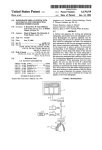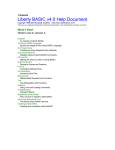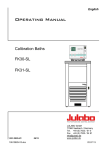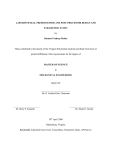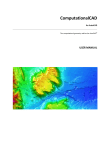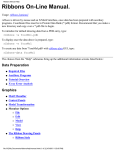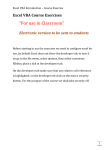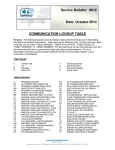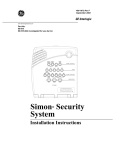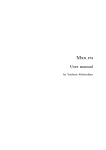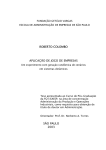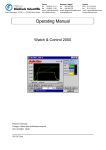Download AN03002_Custom_Widget_Type
Transcript
emWin Window Manager Widgets Custom Widget Type Creation Guide Document: AN03002 Revision: 0 Date: September 6, 2013 A product of SEGGER Microcontroller GmbH & Co. KG www.segger.com 2 Disclaimer Specifications written in this document are believed to be accurate, but are not guaranteed to be entirely free of error. The information in this manual is subject to change for functional or performance improvements without notice. Please make sure your manual is the latest edition. While the information herein is assumed to be accurate, SEGGER Microcontroller GmbH & Co. KG (SEGGER) assumes no responsibility for any errors or omissions. SEGGER makes and you receive no warranties or conditions, express, implied, statutory or in any communication with you. SEGGER specifically disclaims any implied warranty of merchantability or fitness for a particular purpose. Copyright notice You may not extract portions of this manual or modify the PDF file in any way without the prior written permission of SEGGER. The software described in this document is furnished under a license and may only be used or copied in accordance with the terms of such a license. © 2013 SEGGER Microcontroller GmbH & Co. KG, Hilden / Germany Trademarks Names mentioned in this manual may be trademarks of their respective companies. Brand and product names are trademarks or registered trademarks of their respective holders. Contact address SEGGER Microcontroller GmbH & Co. KG In den Weiden 11 D-40721 Hilden Germany Tel.+49 2103-2878-0 Fax.+49 2103-2878-28 E-mail: [email protected] Internet: http://www.segger.com AN03002 Custom Widget Type Creation Guide © 2013 SEGGER Microcontroller GmbH & Co. KG 3 Manual versions This manual describes the current software version. If any error occurs, inform us and we will try to assist you as soon as possible. Contact us for further information on topics or routines not yet specified. Print date: September 6, 2013 Revision Date By 0 130326 AS Description Initial version. AN03002 Custom Widget Type Creation Guide © 2013 SEGGER Microcontroller GmbH & Co. KG 4 AN03002 Custom Widget Type Creation Guide © 2013 SEGGER Microcontroller GmbH & Co. KG 5 About this document Assumptions This document assumes that you already have a solid knowledge of the following: • • • • The software tools used for building your application (assembler, linker, C compiler) The C programming language The target processor DOS command line If you feel that your knowledge of C is not sufficient, we recommend The C Programming Language by Kernighan and Richie (ISBN 0-13-1103628), which describes the standard in C-programming and, in newer editions, also covers the ANSI C standard. How to use this manual This manual explains all the functions and macros that the product offers. It assumes you have a working knowledge of the C language. Knowledge of assembly programming is not required. Typographic conventions for syntax This manual uses the following typographic conventions: Style Used for Body Body text. Keyword Text that you enter at the command-prompt or that appears on the display (that is system functions, file- or pathnames). Parameter Parameters in API functions. Sample Sample code in program examples. Change Changed sample code in program examples. Sample comment Comments in program examples. Reference Reference to chapters, sections, tables and figures or other documents. GUIElement Buttons, dialog boxes, menu names, menu commands. Emphasis Very important sections. Table 1.1: Typographic conventions AN03002 Custom Widget Type Creation Guide © 2013 SEGGER Microcontroller GmbH & Co. KG 6 SEGGER Microcontroller GmbH & Co. KG develops and distributes software development tools and ANSI C software components (middleware) for embedded systems in several industries such as telecom, medical technology, consumer electronics, automotive industry and industrial automation. SEGGER’s intention is to cut software development time for embedded applications by offering compact flexible and easy to use middleware, allowing developers to concentrate on their application. Our most popular products are emWin, a universal graphic software package for embedded applications, and embOS, a small yet efficient real-time kernel. emWin, written entirely in ANSI C, can easily be used on any CPU and most any display. It is complemented by the available PC tools: Bitmap Converter, Font Converter, Simulator and Viewer. embOS supports most 8/16/32-bit CPUs. Its small memory footprint makes it suitable for single-chip applications. Apart from its main focus on software tools, SEGGER develops and produces programming tools for flash micro controllers, as well as J-Link, a JTAG emulator to assist in development, debugging and production, which has rapidly become the industry standard for debug access to ARM cores. Corporate Office: http://www.segger.com EMBEDDED SOFTWARE (Middleware) emWin Graphics software and GUI emWin is designed to provide an efficient, processor- and display controller-independent graphical user interface (GUI) for any application that operates with a graphical display. embOS Real Time Operating System embOS is an RTOS designed to offer the benefits of a complete multitasking system for hard real time applications with minimal resources. embOS/IP TCP/IP stack embOS/IP a high-performance TCP/IP stack that has been optimized for speed, versatility and a small memory footprint. United States Office: http://www.segger-us.com SEGGER TOOLS Flasher Flash programmer Flash Programming tool primarily for micro controllers. J-Link JTAG emulator for ARM cores USB driven JTAG interface for ARM cores. J-Trace JTAG emulator with trace USB driven JTAG interface for ARM cores with Trace memory. supporting the ARM ETM (Embedded Trace Macrocell). J-Link / J-Trace Related Software Add-on software to be used with SEGGER’s industry standard JTAG emulator, this includes flash programming software and flash breakpoints. emFile File system emFile is an embedded file system with FAT12, FAT16 and FAT32 support. Various Device drivers, e.g. for NAND and NOR flashes, SD/MMC and CompactFlash cards, are available. USB-Stack USB device/host stack A USB stack designed to work on any embedded system with a USB controller. Bulk communication and most standard device classes are supported. AN03002 Custom Widget Type Creation Guide © 2013 SEGGER Microcontroller GmbH & Co. KG 7 Table of Contents 1 Introduction ......................................................................................................................9 1.1 1.2 Requirements.......................................................................................... 10 Overview ................................................................................................ 10 2 Creating a custom widget type.......................................................................................11 2.1 2.2 2.3 2.4 2.5 2.6 2.7 2.8 Requirements.......................................................................................... 12 Creating the window ................................................................................ 12 Widget handle ......................................................................................... 12 Widget specific data ................................................................................. 13 Widget specific default properties .............................................................. 16 Setting mandatory properties .................................................................... 17 Setting the callback function ..................................................................... 17 Widget specific callback function ................................................................ 18 3 Example implementation................................................................................................21 3.1 3.2 3.3 Sample description .................................................................................. 22 Internal source code ................................................................................ 22 End user application................................................................................. 25 AN03002 Custom Widget Type Creation Guide © 2013 SEGGER Microcontroller GmbH & Co. KG 8 AN03002 Custom Widget Type Creation Guide © 2013 SEGGER Microcontroller GmbH & Co. KG 9 Chapter 1 Introduction This document is intended to give a short and simple description on how to implement a custom emWin widget. This guide deals with an example implementation of a button. The used functions are explained by their meaning as it is necessary to understand the context. A complete function reference can be found in the according chapter in the emWin user manual, which can be downloaded at www.segger.com. AN03002 Custom Widget Type Creation Guide © 2013 SEGGER Microcontroller GmbH & Co. KG 10 CHAPTER 1 1.1 Introduction Requirements In order to be able to use this document it is required to have a licensed copy of emWin. This guide is written for emWin V5.20, but might be used for later versions as well. Knowledge of the used emWin functions is not required, since cross-references to the according function descriptions in the emWin user manual are included. 1.2 Overview The actual task when implementing a custom widget is to provide the end user with the following: • • • Create()-function which returns a handle to the created widget and allows setting callback function. Set()- and Get()-functions to request and set widget specific properties. Callback()-function to process messages which were sent to the custom widget. In the following chapters the custom function are prefixed MYWIDGET_. These function are the ones which are meant to be used by the end user. AN03002 Custom Widget Type Creation Guide © 2013 SEGGER Microcontroller GmbH & Co. KG 11 Chapter 2 Creating a custom widget type This chapter describes how to implement a custom type of widget. This includes a function to create the widget, a function to handle messages and functions to set and get widget specific properties. AN03002 Custom Widget Type Creation Guide © 2013 SEGGER Microcontroller GmbH & Co. KG 12 CHAPTER 2 2.1 Creating a custom widget type Requirements Since widgets are actually windows with enhanced functionality, it is required to create a window which is able to store additional data. Depending on the actual type of widget to implement, it might be good practice to add further parameters to the prototype of the Create()-function in order to force the user to set up the widget in a certain way right from creation. If a button widget has to be implemented and one might say that it is necessary to define a text which should be displayed on the button, a pointer to a string might be added to the prototype. 2.2 Creating the window The first and basic step is creating a simple window. This can be done using the function WM_CreateWindowAsChild(). The prototype of this function can be copied and used for the custom create function MYWIDGET_Create(): WM_HWIN MYWIDGET_Create(int x0, int y0, int xSize, int ySize, WM_HWIN hWinParent, U32 Style, WM_CALLBACK * pfCallback, int NumExtraBytes) { WM_HWIN hWin; hWin = WM_CreateWindowAsChild(x0, y0, xSize, ySize, hWinParent, Style, pfCallback, NumExtraBytes); return hWin; } The parameters of the function MYWIDGET_Create() are passed to the function WM_CreateWindowAsChild() without any changes. A detailed description of the function can be found in chapter 15.7 "The Window Manager" -> "WM API" in the emWin user manual. 2.3 Widget handle To allow the end user to easily distinguish between widget types, a specific type of handle can be defined: typedef WM_HMEM MYWIDGET_Handle; The prototype of the create function changes accordingly: MYWIDGET_Handle MYWIDGET_Create(int x0, int y0, int xSize, int ySize, WM_HWIN hWinParent, U32 Style, WM_CALLBACK * pfCallback, int NumExtraBytes); AN03002 Custom Widget Type Creation Guide © 2013 SEGGER Microcontroller GmbH & Co. KG 13 2.4 Widget specific data To be able to implement widget specific functionality, widget specific data has to be stored. A simple data structure should be sufficient as shown by the example below: typedef struct { U8 Pressed; GUI_COLOR aBkColor[3]; GUI_COLOR aTextColor[3]; GUI_COLOR FocusColor; const char * pText; int NumExtraBytes; } MYWIDGET_Obj; The background and text colors were declared as arrays, so the state of the widget can be distinguished by its visual appearance. In later sections, the following defines are used to access the color arrays according to the current state of the widget. #define MYWIDGET_CI_UNPRESSED 0 #define MYWIDGET_CI_PRESSED 1 #define MYWIDGET_CI_DISABLED 2 The included variables of the MYWIDGET_Obj-structure can be defined as it is required by the actual type of widget to implement. The only variable which is required in every case is a variable to store the number of bytes which is defined by the end user at creation. In this case it is called NumExtraBytes. For the type of button widget, which is implemented in this guide the contained variables are used to store the state, the state specific colors and a pointer to a string. This structure is going to be stored as user data. Nevertheless the opportunity for the end user to attach data to the widget has to be preserved. The function MYWIDGET_Create() changes as follows: MYWIDGET_Handle MYWIDGET_Create(int x0, int y0, int xSize, int ySize, WM_HWIN hWinParent, U32 Style, WM_CALLBACK * pfCallback, int NumExtraBytes) { MYWIDGET_Handle hWin; hWin = WM_CreateWindowAsChild(x0, y0, xSize, ySize, hWinParent, Style, pfCallback, sizeof(MYWIDGET_Obj) + NumExtraBytes); return hWin; } Warning: The end user must not use the function WM_GetUserData() or WM_SetUserData() with a widget of a custom type as it is implemented using this guide, since he would either overwrite widget specific data, or not retrieve the data he actually expects. Therefor custom functions for these purposes have to be implemented as shown in the following: AN03002 Custom Widget Type Creation Guide © 2013 SEGGER Microcontroller GmbH & Co. KG 14 CHAPTER 2 Creating a custom widget type MYWIDGET_GetUserData() Function description Copies the given number of bytes of user data to the destination buffer. Implementation int MYWIDGET_GetUserData(MYWIDGET_Handle hWin, void * pDest, int SizeOfBuffer) { MYWIDGET_Obj MyWidget; int NumBytes; U8 * pExtraBytes; if (SizeOfBuffer <= 0) { return 0; } WM_GetUserData(hWin, &MyWidget, sizeof(MYWIDGET_Obj)); pExtraBytes = (U8 *)malloc(sizeof(MYWIDGET_Obj) + MyWidget.NumExtraBytes); if (pExtraBytes) { WM_GetUserData(hWin, pExtraBytes, sizeof(MYWIDGET_Obj) + MyWidget.NumExtraBytes); if (SizeOfBuffer >= MyWidget.NumExtraBytes) { NumBytes = MyWidget.NumExtraBytes; } else { NumBytes = SizeOfBuffer; } GUI_MEMCPY(pDest, pExtraBytes + sizeof(MYWIDGET_Obj), NumBytes); free(pExtraBytes); return NumBytes; } return 0; } Parameter hWin pDest SizeOfBuffer Description Handle to the Widget. Pointer to the destination buffer. Size of the destination buffer. Table 2.1: MYWIDGET_GetUserData() parameter list Return value Number of copied bytes. AN03002 Custom Widget Type Creation Guide © 2013 SEGGER Microcontroller GmbH & Co. KG 15 MYWIDGET_SetUserData() Function description Sets the given number of bytes of the source buffer as user data. Implementation int MYWIDGET_SetUserData(MYWIDGET_Handle hWin, void * pSrc, int SizeOfBuffer) { MYWIDGET_Obj MyWidget; int NumBytes; U8 * pExtraBytes; if (SizeOfBuffer <= 0) { return 1; } WM_GetUserData(hWin, &MyWidget, sizeof(MYWIDGET_Obj)); pExtraBytes = (U8 *)malloc(sizeof(MYWIDGET_Obj) + MyWidget.NumExtraBytes); if (pExtraBytes) { WM_GetUserData(hWin, pExtraBytes, sizeof(MYWIDGET_Obj) + MyWidget.NumExtraBytes); if (SizeOfBuffer >= MyWidget.NumExtraBytes) { NumBytes = MyWidget.NumExtraBytes; } else { NumBytes = SizeOfBuffer; } GUI_MEMCPY(pExtraBytes + sizeof(MYWIDGET_Obj), pSrc, NumBytes); WM_SetUserData(hWin, pExtraBytes, sizeof(MYWIDGET_Obj) + MyWidget.NumExtraBytes); free(pExtraBytes); return 0; } return 1; } Parameter hWin pSrc SizeOfBuffer Description Handle to the Widget. Pointer to the source buffer. Size of the source buffer. Table 2.2: MYWIDGET_SetUserData() parameter list Return value 0, on success. 1, on error. AN03002 Custom Widget Type Creation Guide © 2013 SEGGER Microcontroller GmbH & Co. KG 16 CHAPTER 2 2.5 Creating a custom widget type Widget specific default properties Default values should be defined for every property, which is not explicitly set by the user at creation. According to the MYWIDGET_Obj-structure the default values might be defined as shown below: const MYWIDGET_Obj MYWIDGET_Default = { 0, // U8 Pressed; { GUI_DARKBLUE, GUI_LIGHTBLUE, GUI_GRAY }, // GUI_COLOR aBkColor[3]; { GUI_WHITE, GUI_DARKGRAY, GUI_LIGHTGRAY }, // GUI_COLOR aTextColor[3]; GUI_ORANGE, // GUI_COLOR FocusColor; NULL, // const char * pText; 0 // int NumExtraBytes; }; These values are used when the widget is created. The function MYWIDGET_Create() changes as follows: MYWIDGET_Handle MYWIDGET_Create(int x0, int y0, int xSize, int ySize, WM_HWIN hWinParent, U32 Style, WM_CALLBACK * pfCallback, int NumExtraBytes) { MYWIDGET_Handle hWin; MYWIDGET_Obj MyWidget; hWin = WM_CreateWindowAsChild(x0, y0, xSize, ySize, hWinParent, Style, pfCallback, sizeof(MYWIDGET_Obj) + NumExtraBytes); MyWidget = MYWIDGET_Default; MyWidget.NumExtraBytes = NumExtraBytes; WM_SetUserData(hWin, &MyWidget, sizeof(MYWIDGET_Obj)); return hWin; } AN03002 Custom Widget Type Creation Guide © 2013 SEGGER Microcontroller GmbH & Co. KG 17 2.6 Setting mandatory properties Assuming it is mandatory or at least usual for a button to display a text on top, the function MYWIDGET_Create() can be changed as follows: MYWIDGET_Handle MYWIDGET_Create(int x0, int y0, int xSize, int ySize, WM_HWIN hWinParent, U32 Style, const char * pText, WM_CALLBACK * pfCallback, int NumExtraBytes) { MYWIDGET_Handle hWin; MYWIDGET_Obj MyWidget; hWin = WM_CreateWindowAsChild(x0, y0, xSize, ySize, hWinParent, Style, pfCallback, sizeof(MYWIDGET_Obj) + NumExtraBytes); MyWidget = MYWIDGET_Default; MyWidget.NumExtraBytes = NumExtraBytes; if (pText) { MyWidget.pText = pText; } WM_SetUserData(hWin, &MyWidget, sizeof(MYWIDGET_Obj)); return hWin; } MyWidget.pText is set to pText after the default values were applied. 2.7 Setting the callback function The last and most important part of implementing the Create()-function is setting the window to use the widget specific callback function. Since the opportunity for the end user to implement a custom callback function has to be preserved, it should be checked if a pointer to a custom callback function was passed: MYWIDGET_Handle MYWIDGET_Create(int x0, int y0, int xSize, int ySize, WM_HWIN hWinParent, U32 Style, const char * pText, WM_CALLBACK * pfCallback, int NumExtraBytes) { MYWIDGET_Handle hWin; MYWIDGET_Obj MyWidget; WM_CALLBACK * pfUsed; if (pfCallback) { pfUsed = pfCallback; } else { pfUsed = MYWIDGET_Callback; } hWin = WM_CreateWindowAsChild(x0, y0, xSize, ySize, hWinParent, Style, pfUsed, sizeof(MYWIDGET_Obj) + NumExtraBytes); MyWidget = MYWIDGET_Default; MyWidget.NumExtraBytes = NumExtraBytes; if (pText) { MyWidget.pText = pText; } WM_SetUserData(hWin, &MyWidget, sizeof(MYWIDGET_Obj)); return hWin; } AN03002 Custom Widget Type Creation Guide © 2013 SEGGER Microcontroller GmbH & Co. KG 18 CHAPTER 2 2.8 Creating a custom widget type Widget specific callback function The callback function makes the user recognize the type of the widget. It is responsible for drawing the widget as well as for reacting on other events like keyboard- or touch-events. Since this guide deals with an example implementation for a custom button widget, it is sufficient to deal with the message WM_PAINT, WM_TOUCH and WM_SET_FOCUS. A complete reference of messages as well as a detailed description on how the Window Manager’s callback mechanism works can be found in the emWin user manual in chapter 15 "The Window Manager". The first step is using the starting point: void MYWIDGET_Callback(WM_MESSAGE * pMsg) { switch (pMsg->MsgId) { default: WM_DefaultProc(pMsg); } } In order to have a visual impact on the widget, a reaction to the WM_PAINT-message is implemented. Since the colors to use are stored in the user data, they have to be fetched first: void MYWIDGET_Callback(WM_MESSAGE * pMsg) { MYWIDGET_Handle hWin; MYWIDGET_Obj MyWidget; GUI_RECT WinRect; int ColorIndex; hWin = pMsg->hWin; // // Get the window coordinates and widget specific data // WM_GetWindowRectEx(hWin, &WinRect); GUI_MoveRect(&WinRect, -WinRect.x0, -WinRect.y0); WM_GetUserData(hWin, &MyWidget, sizeof(MYWIDGET_Obj)); switch (pMsg->MsgId) { case WM_PAINT: // // Determine the color according to the current state // if (WM_IsEnabled(hWin)) { if (MyWidget.Pressed) { ColorIndex = MYWIDGET_CI_PRESSED; } else { ColorIndex = MYWIDGET_CI_UNPRESSED; } } else { ColorIndex = MYWIDGET_CI_DISABLED; } // // Draw the background // GUI_SetColor(MyWidget.aBkColor[ColorIndex]); GUI_FillRectEx(&WinRect); // // Draw the focus rectangle // if (WM_HasFocus(hWin)) { GUI_SetColor(MyWidget.FocusColor); GUI_DrawRectEx(&WinRect); } // // Display the text. // GUI_SetColor(MyWidget.aTextColor[ColorIndex]); GUI_SetTextMode(GUI_TM_TRANS); GUI_DispStringInRect(MyWidget.pText, &WinRect, GUI_TA_HCENTER | GUI_TA_VCENTER); break; default: WM_DefaultProc(pMsg); } } AN03002 Custom Widget Type Creation Guide © 2013 SEGGER Microcontroller GmbH & Co. KG 19 At this point the code can be run and the widget can be recognized as a rectangle on the screen. Since this is going to be a button, one may expect a change when it is clicked, but nothing happens. The reason is that the variable MyWidget.Pressed is never changed, so the widget is drawn the same way regardless the pressed state. In order to update the state, it is required to react to the message WM_TOUCH: void MYWIDGET_Callback(WM_MESSAGE * pMsg) { MYWIDGET_Handle hWin; GUI_PID_STATE * pState; MYWIDGET_Obj MyWidget; GUI_RECT WinRect; int ColorIndex; hWin = pMsg->hWin; WM_GetWindowRectEx(hWin, &WinRect); GUI_MoveRect(&WinRect, -WinRect.x0, -WinRect.y0); WM_GetUserData(hWin, &MyWidget, sizeof(MYWIDGET_Obj)); switch (pMsg->MsgId) { case WM_PAINT: if (WM_IsEnabled(hWin)) { if (MyWidget.Pressed) { ColorIndex = MYWIDGET_CI_PRESSED; } else { ColorIndex = MYWIDGET_CI_UNPRESSED; } } else { ColorIndex = MYWIDGET_CI_DISABLED; } GUI_SetColor(MyWidget.aBkColor[ColorIndex]); GUI_FillRectEx(&WinRect); if (WM_HasFocus(hWin)) { GUI_SetColor(MyWidget.FocusColor); GUI_DrawRectEx(&WinRect); } GUI_SetColor(MyWidget.aTextColor[ColorIndex]); GUI_SetTextMode(GUI_TM_TRANS); GUI_DispStringInRect(MyWidget.pText, &WinRect, GUI_TA_HCENTER | GUI_TA_VCENTER); break; case WM_TOUCH: if (pMsg->Data.p) { pState = (GUI_PID_STATE *)pMsg->Data.p; if (MyWidget.Pressed != pState->Pressed) { MyWidget.Pressed = pState->Pressed; WM_SetUserData(hWin, &MyWidget, sizeof(MYWIDGET_Obj)); if (MyWidget.Pressed) { WM_SetFocus(hWin); } WM_InvalidateWindow(hWin); } } else { MyWidget.Pressed = 0; WM_SetUserData(hWin, &MyWidget, sizeof(MYWIDGET_Obj)); WM_InvalidateWindow(hWin); } break; default: WM_DefaultProc(pMsg); } } The additional code retrieves the PID state which is sent along with the WM_TOUCHmessage and sets the user data accordingly. After updating the widget specific data the widget is invalidated in order to receive a new WM_PAINT-message. When running this code clicking the widget will cause the color to change. Nevertheless the focus rectangle is not drawn, although the function WM_SetFocus() is called when the widget receives a pressed PID state. The reason for this behavior is that the widget never "accepts" the focus. To do so the callback function needs to react to the WM_SET_FOCUS-message as shown below: AN03002 Custom Widget Type Creation Guide © 2013 SEGGER Microcontroller GmbH & Co. KG 20 CHAPTER 2 Creating a custom widget type void MYWIDGET_Callback(WM_MESSAGE * pMsg) { MYWIDGET_Handle hWin; GUI_PID_STATE * pState; MYWIDGET_Obj MyWidget; GUI_RECT WinRect; int ColorIndex; hWin = pMsg->hWin; WM_GetWindowRectEx(hWin, &WinRect); GUI_MoveRect(&WinRect, -WinRect.x0, -WinRect.y0); WM_GetUserData(hWin, &MyWidget, sizeof(MYWIDGET_Obj)); switch (pMsg->MsgId) { case WM_PAINT: if (WM_IsEnabled(hWin)) { if (MyWidget.Pressed) { ColorIndex = MYWIDGET_CI_PRESSED; } else { ColorIndex = MYWIDGET_CI_UNPRESSED; } } else { ColorIndex = MYWIDGET_CI_DISABLED; } GUI_SetColor(MyWidget.aBkColor[ColorIndex]); GUI_FillRectEx(&WinRect); if (WM_HasFocus(hWin)) { GUI_SetColor(MyWidget.FocusColor); GUI_DrawRectEx(&WinRect); } GUI_SetColor(MyWidget.aTextColor[ColorIndex]); GUI_SetTextMode(GUI_TM_TRANS); GUI_DispStringInRect(MyWidget.pText, &WinRect, GUI_TA_HCENTER | GUI_TA_VCENTER); break; case WM_TOUCH: pState = (GUI_PID_STATE *)pMsg->Data.p; if (MyWidget.Pressed != pState->Pressed) { MyWidget.Pressed = pState->Pressed; WM_SetUserData(hWin, &MyWidget, sizeof(MYWIDGET_Obj)); if (MyWidget.Pressed) { WM_SetFocus(hWin); } WM_InvalidateWindow(hWin); } break; case WM_SET_FOCUS: if (pMsg->Data.v) { pMsg->Data.v = 0; } WM_InvalidateWindow(hWin); break; default: WM_DefaultProc(pMsg); } } pMsg->Data.v = 1 means that the widget receives the focus. In order to let the Window Manager "know" that the focus was accepted, the value has to be set to 0. Otherwise the focus is not received. Once the widget gains or loses the focus, it should be invalidated so the appearance changes accordingly, if it is intended to do so. AN03002 Custom Widget Type Creation Guide © 2013 SEGGER Microcontroller GmbH & Co. KG 21 Chapter 3 Example implementation This chapter shows an example application, which includes the complete source code which was explained in the previous chapter as well as the usage of a custom user callback function and user data. Additionally a BUTTON widget is used to make the change of the focus recognizable. AN03002 Custom Widget Type Creation Guide © 2013 SEGGER Microcontroller GmbH & Co. KG 22 3.1 CHAPTER 3 Example implementation Sample description The following sample shows the internal implementation of the custom widget type, which actually is a button, and also shows an end user application, which uses a custom callback function to display the text which was previously stored as widget user data. 3.2 Internal source code #include #include #include #include #include <string.h> <stdlib.h> "GUI.h" "WM.h" "BUTTON.h" // Definition of NULL // malloc() and free() /********************************************************************* * * Color indices */ #define MYWIDGET_CI_UNPRESSED 0 #define MYWIDGET_CI_PRESSED 1 #define MYWIDGET_CI_DISABLED 2 /********************************************************************* * * Typedef */ typedef WM_HMEM MYWIDGET_Handle; /********************************************************************* * * MYWIDGET_Obj */ typedef struct { U8 Pressed; GUI_COLOR aBkColor[3]; GUI_COLOR aTextColor[3]; GUI_COLOR FocusColor; const char * pText; int NumExtraBytes; } MYWIDGET_Obj; /********************************************************************* * * MYWIDGET_Default */ const MYWIDGET_Obj MYWIDGET_Default = { 0, { GUI_DARKBLUE, GUI_LIGHTBLUE, GUI_GRAY }, { GUI_WHITE, GUI_DARKGRAY, GUI_LIGHTGRAY }, GUI_ORANGE, NULL, 0 }; AN03002 Custom Widget Type Creation Guide © 2013 SEGGER Microcontroller GmbH & Co. KG 23 /********************************************************************* * * MYWIDGET_Callback */ void MYWIDGET_Callback(WM_MESSAGE * pMsg) { MYWIDGET_Handle hWin; GUI_PID_STATE * pState; MYWIDGET_Obj MyWidget; GUI_RECT WinRect; int ColorIndex; hWin = pMsg->hWin; WM_GetWindowRectEx(hWin, &WinRect); GUI_MoveRect(&WinRect, -WinRect.x0, -WinRect.y0); WM_GetUserData(hWin, &MyWidget, sizeof(MYWIDGET_Obj)); switch (pMsg->MsgId) { case WM_PAINT: if (WM_IsEnabled(hWin)) { if (MyWidget.Pressed) { ColorIndex = MYWIDGET_CI_PRESSED; } else { ColorIndex = MYWIDGET_CI_UNPRESSED; } } else { ColorIndex = MYWIDGET_CI_DISABLED; } GUI_SetColor(MyWidget.aBkColor[ColorIndex]); GUI_FillRectEx(&WinRect); if (WM_HasFocus(hWin)) { GUI_SetColor(MyWidget.FocusColor); GUI_DrawRectEx(&WinRect); } GUI_SetColor(MyWidget.aTextColor[ColorIndex]); GUI_SetTextMode(GUI_TM_TRANS); GUI_DispStringInRect(MyWidget.pText, &WinRect, GUI_TA_HCENTER | GUI_TA_VCENTER); break; case WM_TOUCH: if (pMsg->Data.p) { pState = (GUI_PID_STATE *)pMsg->Data.p; if (MyWidget.Pressed != pState->Pressed) { MyWidget.Pressed = pState->Pressed; WM_SetUserData(hWin, &MyWidget, sizeof(MYWIDGET_Obj)); if (MyWidget.Pressed) { WM_SetFocus(hWin); } WM_InvalidateWindow(hWin); } } else { MyWidget.Pressed = 0; WM_SetUserData(hWin, &MyWidget, sizeof(MYWIDGET_Obj)); WM_InvalidateWindow(hWin); } break; case WM_SET_FOCUS: if (pMsg->Data.v) { pMsg->Data.v = 0; } WM_InvalidateWindow(hWin); break; default: WM_DefaultProc(pMsg); } } AN03002 Custom Widget Type Creation Guide © 2013 SEGGER Microcontroller GmbH & Co. KG 24 CHAPTER 3 Example implementation /********************************************************************* * * MYWIDGET_GetUserData */ int MYWIDGET_GetUserData(MYWIDGET_Handle hWin, void * pDest, int SizeOfBuffer) { MYWIDGET_Obj MyWidget; int NumBytes; U8 * pExtraBytes; if (SizeOfBuffer <= 0) { return 0; } WM_GetUserData(hWin, &MyWidget, sizeof(MYWIDGET_Obj)); pExtraBytes = (U8 *)malloc(sizeof(MYWIDGET_Obj) + MyWidget.NumExtraBytes); if (pExtraBytes) { WM_GetUserData(hWin, pExtraBytes, sizeof(MYWIDGET_Obj) + MyWidget.NumExtraBytes); if (SizeOfBuffer >= MyWidget.NumExtraBytes) { NumBytes = MyWidget.NumExtraBytes; } else { NumBytes = SizeOfBuffer; } GUI_MEMCPY(pDest, pExtraBytes + sizeof(MYWIDGET_Obj), NumBytes); free(pExtraBytes); return NumBytes; } return 0; } /********************************************************************* * * MYWIDGET_SetUserData */ int MYWIDGET_SetUserData(MYWIDGET_Handle hWin, void * pSrc, int SizeOfBuffer) { MYWIDGET_Obj MyWidget; int NumBytes; U8 * pExtraBytes; if (SizeOfBuffer <= 0) { return 1; } WM_GetUserData(hWin, &MyWidget, sizeof(MYWIDGET_Obj)); pExtraBytes = (U8 *)malloc(sizeof(MYWIDGET_Obj) + MyWidget.NumExtraBytes); if (pExtraBytes) { WM_GetUserData(hWin, pExtraBytes, sizeof(MYWIDGET_Obj) + MyWidget.NumExtraBytes); if (SizeOfBuffer >= MyWidget.NumExtraBytes) { NumBytes = MyWidget.NumExtraBytes; } else { NumBytes = SizeOfBuffer; } GUI_MEMCPY(pExtraBytes + sizeof(MYWIDGET_Obj), pSrc, NumBytes); WM_SetUserData(hWin, pExtraBytes, sizeof(MYWIDGET_Obj) + MyWidget.NumExtraBytes); free(pExtraBytes); return 0; } return 1; } AN03002 Custom Widget Type Creation Guide © 2013 SEGGER Microcontroller GmbH & Co. KG 25 /********************************************************************* * * MYWIDGET_Create */ MYWIDGET_Handle MYWIDGET_Create(int x0, int y0, int xSize, int ySize, WM_HWIN hWinParent, U32 Style, const char * pText, WM_CALLBACK * pfCallback, int NumExtraBytes) { MYWIDGET_Handle hWin; MYWIDGET_Obj MyWidget; WM_CALLBACK * pfUsed; if (pfCallback) { pfUsed = pfCallback; } else { pfUsed = MYWIDGET_Callback; } MyWidget = MYWIDGET_Default; MyWidget.NumExtraBytes = NumExtraBytes; if (pText) { MyWidget.pText = pText; } hWin = WM_CreateWindowAsChild(x0, y0, xSize, ySize, hWinParent, Style, pfUsed, sizeof(MYWIDGET_Obj) + NumExtraBytes); WM_SetUserData(hWin, &MyWidget, sizeof(MYWIDGET_Obj)); return hWin; } 3.3 End user application /********************************************************************* * * _cbMyWidget */ void _cbMyWidget(WM_MESSAGE * pMsg) { GUI_RECT WinRect; char acText[20] = { 0 }; switch (pMsg->MsgId) { case WM_PAINT: MYWIDGET_Callback(pMsg); MYWIDGET_GetUserData(pMsg->hWin, acText, sizeof(acText)); GUI_SetColor(GUI_WHITE); GUI_SetTextMode(GUI_TM_TRANS); WM_GetWindowRectEx(pMsg->hWin, &WinRect); GUI_MoveRect(&WinRect, -WinRect.x0, -WinRect.y0); GUI_DispStringInRect(acText, &WinRect, GUI_TA_HCENTER | GUI_TA_VCENTER); break; default: MYWIDGET_Callback(pMsg); } } /********************************************************************* * * MainTask */ void MainTask(void) { MYWIDGET_Handle hMyWidget; char acExtraBytes[] = "Extrabytes"; GUI_Init(); hMyWidget = MYWIDGET_Create(10, 10, 100, 50, WM_HBKWIN, WM_CF_SHOW, NULL, _cbMyWidget, strlen(acExtraBytes)); MYWIDGET_SetUserData(hMyWidget, acExtraBytes, strlen(acExtraBytes)); BUTTON_Create(10, 100, 100, 50, 0, WM_CF_SHOW); while (1) { GUI_Delay(100); } } AN03002 Custom Widget Type Creation Guide © 2013 SEGGER Microcontroller GmbH & Co. KG 26 AN03002 Custom Widget Type Creation Guide CHAPTER 3 Example implementation © 2013 SEGGER Microcontroller GmbH & Co. KG 27 Index Symbols N _cbMyWidget ......................................25 NumExtraBytes ................................... 13 C O Callback function .................................17 Callback mechanism .............................18 Color indices .......................................22 Creating the window ............................12 Custom widget type .............................11 Overview ........................................... 10 D Default properties ................................16 E emWin user manual .............................. 9 End user .............................................13 End user application .............................25 Example implementation ......................21 G GUI_PID_STATE ..................................19 I Internal source code ............................22 Introduction ......................................... 9 M MainTask ............................................25 Mandatory properties ...........................17 MYWIDGET_Callback ...................... 18, 23 MYWIDGET_CI_DISABLED .............. 13, 18 MYWIDGET_CI_PRESSED ................ 13, 18 MYWIDGET_CI_UNPRESSED ............ 13, 18 MYWIDGET_Create ................... 12–13, 25 MYWIDGET_Default ........................ 16, 22 MYWIDGET_GetUserData ................ 14, 24 MYWIDGET_Handle ..............................12 MYWIDGET_Obj ............................. 13, 22 MYWIDGET_SetUserData ................ 15, 24 AN03002 Custom Widget Type Creation Guide R Requirements ................................ 10, 12 S Sample description .............................. 22 Syntax, conventions used ....................... 5 T Typedef ............................................. 22 typedef .............................................. 12 W Widget handle .................................... 12 Widget specific callback function ........... 18 Widget specific data ............................ 13 WM_CreateWindowAsChild ................... 12 WM_GetUserData ................................ 13 WM_HMEM ......................................... 12 WM_PAINT ......................................... 18 WM_SET_FOCUS ................................. 18 WM_SetUserData ................................ 13 WM_TOUCH ....................................... 18 www.segger.com ................................... 9 © 2013 SEGGER Microcontroller GmbH & Co. KG 28 AN03002 Custom Widget Type Creation Guide Index © 2013 SEGGER Microcontroller GmbH & Co. KG





























